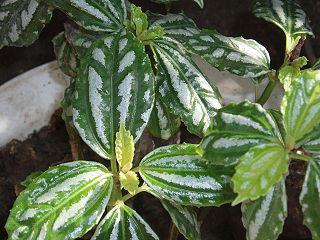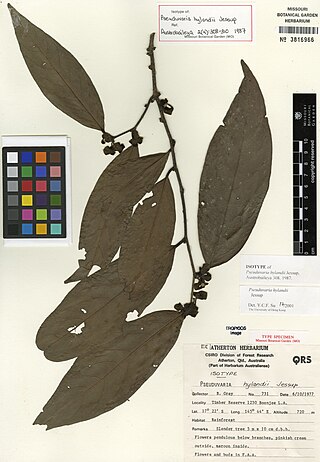This page provides a glossary of plant morphology. Botanists and other biologists who study plant morphology use a number of different terms to classify and identify plant organs and parts that can be observed using no more than a handheld magnifying lens. This page provides help in understanding the numerous other pages describing plants by their various taxa. The accompanying page—Plant morphology—provides an overview of the science of the external form of plants. There is also an alphabetical list: Glossary of botanical terms. In contrast, this page deals with botanical terms in a systematic manner, with some illustrations, and organized by plant anatomy and function in plant physiology.

Allagoptera caudescens is a species of flowering plant in the palm family endemic to Brazil, where it is known as buri palm. The older name Polyandrococos combines the Greek words for "many" and "anther" with the name of another palm genus Cocos, and the epithet is Latin for "bearlike", referring to the hairy tomentum. It was formerly classified as Polyandrococos caudescens, the only species in the genus Polyandrococos.

Pilea cadierei is a species of flowering plant in the nettle family Urticaceae. The species is endemic to the southern Chinese provinces of Guizhou and Yunnan, as well as Vietnam. The specific epithet cadierei refers to the 20th-century botanist R.P. Cadière. P. cadierei has earned the Royal Horticultural Society's Award of Garden Merit for its hardiness and reliability as a houseplant. In warmer countries, usually within USDA zones 8-12, the plant may be grown outside year-round as a perennial, either in-ground or contained, and pruned about 50% during the autumn.

Puya alpestris is a species of bromeliad endemic to the Chilean Andes. It is native to dry hills, rock outcrops in central and southern Chile at elevations of 0 to 2200 meters. It is one of the most southerly occurring species within the family. It is one of the few Puya species that are grown in some parks and gardens as an ornamental plant.

Brunfelsia pauciflora is a species of flowering plant in the family Solanaceae, the nightshades. It is endemic to Brazil, and it is grown in cultivation. A shrubby perennial plant grown in gardens, its common names include today, tomorrow together, yesterday, today and tomorrow, morning-noon-and-night, kiss me quick, and Brazil raintree.

Cautleya is a small genus of perennial plants of the family Zingiberaceae, found in the eastern Himalayas through to China and Vietnam. It consists of two species of high-altitude tropical and temperate plants, native to cool forest areas – an unusual habitat for members of the Zingiberaceae. They are grown as ornamental flowering plants.
Drosera peruensis is a carnivorous plant of the genus Drosera, commonly known as the Peruvian sundew. This Drosera species was first identified in Peru in 2002 by Tânia Regina dos Santos Silva and Mireya D. Correa following work to update the genus Drosera for the reference text, Flora Neotropica..

Meconopsis horridula, the prickly blue poppy, is a flowering plant from the family Papaveraceae. It is an endangered species that grows in high altitudes. The height of the plant varies from 20 cm to 1m. It is a monocarpic, dicot plant.

Cautleya spicata is a perennial herbaceous plant in the family Zingiberaceae. It is found in the Himalayas through to China (Yunnan). It is cultivated as an ornamental garden plant, hardy to a few degrees of frost.
Salix cathayana is a strongly branched shrub from the genus of the willow (Salix) with brown or gray-brown, young tomentose hairy branches. The leaf blades have lengths of 1.5 to 5.2 centimeters. The natural range of the species is in the north of China.
Salix dalungensis is a small tree from the genus of willow (Salix) with mostly 4 to 5 centimeters long leaf blades. The natural range of the species is in Tibet.
Salix dibapha is a shrub from the genus of willow (Salix) with mostly 4 to 6 centimeters long leaf blades. The natural range of the species is in China.
Larsenianthus careyanus is a species of the ginger family (Zingiberaceae). It occurs in Bangladesh as well as northeast India. It is the type species of the genus Larsenianthus, which was newly established in 2010.
Larsenianthus assamensis is a species of the genus Larsenianthus in the ginger family (Zingiberaceae). It was first described in 2010 and is native to northeastern India.
Larsenianthus arunachalensis is a species of the genus Larsenianthus in the ginger family (Zingiberaceae).. It was first described in 2010 and is native to northeastern India, and Myanmar.

Salix erioclada is a species from the genus of willows (Salix) and grows as a shrub or small tree. The leaf blades have a length of about 5 centimeters. The natural range of the species is in China.

Pseuduvaria hylandii is a species of plant in the family Annonaceae. It is native to Australia. L.W. Jessup, the botanists who first formally described the species, named it after Bernard Hyland an Australian botanist who collected the specimen he examined.

Kalanchoe sexangularis, also known as bushveld kalanchoe, six-angled kalanchoe, or red-leaved kalanchoe, is a species of the succulent genus Kalanchoe, in the family Crassulaceae that is native to Southern Africa.

Babiana lobata is a species of geophyte of 12–25 cm (4.7–9.8 in) high that is assigned to the family Iridaceae. It has leaves that consist of a sheath and a blade that are at a slight angle with each other. The leaf blades are narrow, sword- to lance-shaped and have a left and right surface, rather than an upper and lower surface. The leaf blades are slightly pleated and hairless. The inflorescence contains seven to twelve bluish mauve mirror-symmetrical flowers comprising six tepals, with the lower lateral tepals yellow sometimes flushed mauve at their tips, and with three stamens crowding under the dorsal tepal. Flowering occurs in July and August. The flowers emit a faint acrid-metallic scent. B. lobata grows in part of the Richtersveld in the Northern Cape province of South Africa.
Hypericum hirtellum is a species of flowering plant in the family Hypericaceae. It is native to Iran and Iraq and is found on chalky, sandy soil at elevations of 300–2,000 meters.














